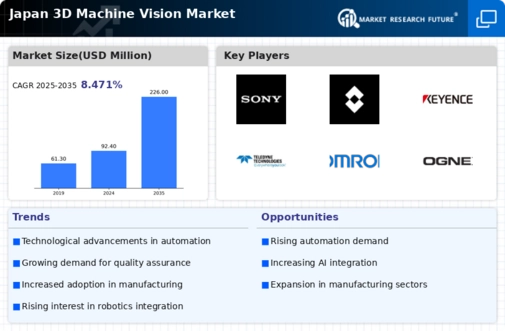Increased Investment in R&D
Investment in research and development (R&D) within Japan's technology sector is significantly influencing the 3d machine-vision market. Companies are allocating substantial resources to develop innovative solutions that enhance the capabilities of machine-vision systems. This focus on R&D is expected to yield breakthroughs in areas such as speed, accuracy, and adaptability of vision technologies. With an estimated increase in R&D spending by 12% in the coming years, the market is likely to benefit from a continuous influx of advanced technologies, fostering growth and competitiveness in the 3D machine-vision sector.
Rising Adoption of Robotics
The integration of robotics in various sectors is driving the 3d machine-vision market in Japan. As industries increasingly adopt automation, the need for advanced vision systems becomes paramount. Robotics equipped with 3D vision capabilities enhance precision and efficiency in tasks such as assembly, inspection, and packaging. In 2025, the robotics market in Japan is projected to reach approximately $10 billion, indicating a robust growth trajectory. This trend suggests that as more companies invest in robotic solutions, the demand for 3D machine-vision systems will likely increase, further propelling the market forward.
Surge in Quality Assurance Standards
In Japan, the emphasis on quality assurance across manufacturing sectors is significantly impacting the 3d machine-vision market. Stricter regulations and standards necessitate the implementation of advanced inspection technologies to ensure product quality. Industries such as automotive and electronics are particularly affected, as they require high precision and reliability. The market for quality control solutions is expected to grow by 15% annually, indicating a strong correlation with the demand for 3D machine-vision systems. This trend underscores the importance of integrating sophisticated vision technologies to meet evolving quality standards.
Technological Innovations in Imaging
Technological advancements in imaging technologies are reshaping the 3d machine-vision market in Japan. Innovations such as improved sensors, enhanced algorithms, and faster processing capabilities are enabling more accurate and efficient vision systems. The introduction of AI and machine learning into imaging processes is particularly noteworthy, as it allows for real-time analysis and decision-making. As these technologies evolve, the market is expected to expand, with projections indicating a growth rate of 20% over the next five years. This suggests that continuous innovation will play a crucial role in the market's development.
Expansion of E-commerce and Logistics
The rapid growth of e-commerce in Japan is creating new opportunities for the 3d machine-vision market. As online shopping continues to rise, logistics and warehousing operations are increasingly adopting automated systems to manage inventory and fulfill orders efficiently. The demand for 3D vision systems in sorting, packing, and quality control is likely to surge, with the logistics sector projected to grow by 10% annually. This trend indicates that the integration of 3D machine-vision technologies will be essential for companies aiming to enhance operational efficiency and meet consumer expectations.



















Leave a Comment